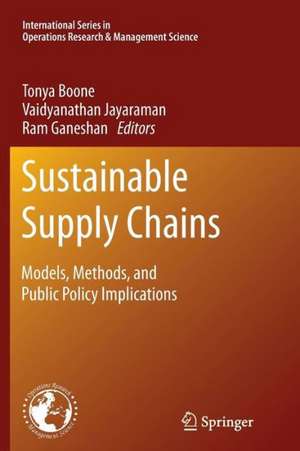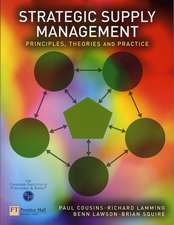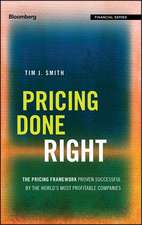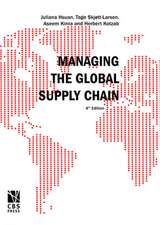Sustainable Supply Chains: Models, Methods, and Public Policy Implications: International Series in Operations Research & Management Science, cartea 174
Editat de Tonya Boone, Vaidyanathan Jayaraman, Ram Ganeshanen Limba Engleză Paperback – 17 iul 2014
This edited volume is made up of fifteen chapters loosely grouped into clusters. After an introduction, chapter 2 shows the greenhouse emissions at various levels, from countries all the way to individual products. Chapters 3-7 each focus on an industrial sector and address issues specific to that industry, with chapter 7 presenting a case study on LEED certification of Miller Hall, home of the Mason School of Business where two of the authors (Tonya and Ram) work. Chapters 8-10 address product take back in the supply chain. Chapter 8 introduces e-waste and surveys what firms are doing to combat it. Chapter 9 provides an overview of existing take-back legislation and academic papers that have studied various research questions associated with them. Chapter 10 is a tutorial that addresses the problem of product disposition on a closed-loop supply chain: what should a firm do with a product return?
Chapters 11-15 address measurement, monitoring, decision-making, and reporting regarding environmental issues in a firm. Chapter 11 provides an academic survey of eco-labeling and the consumer’s willingness to pay for them. Chapter 12 discusses how firms can measure the total carbon footprint in their supply chains and some of the strategies they can use to mitigate carbon emissions. Using the price of call options, chapter 13illustrates how managers can quantify the savings attributed to sustainability-related investment. Chapter 14 develops a non-linear optimization model that addresses the complex trade-offs involved in making joint operational and environmental decisions. Finally, chapter 15 develops a Data Envelopment Analysis-based method for supplier evaluation incorporating environmental and business factors.
| Toate formatele și edițiile | Preț | Express |
|---|---|---|
| Paperback (1) | 942.63 lei 6-8 săpt. | |
| Springer – 17 iul 2014 | 942.63 lei 6-8 săpt. | |
| Hardback (1) | 947.35 lei 6-8 săpt. | |
| Springer – 8 iun 2012 | 947.35 lei 6-8 săpt. |
Din seria International Series in Operations Research & Management Science
- 20%
 Preț: 331.25 lei
Preț: 331.25 lei - 9%
 Preț: 696.06 lei
Preț: 696.06 lei - 20%
 Preț: 570.62 lei
Preț: 570.62 lei - 18%
 Preț: 1132.02 lei
Preț: 1132.02 lei - 18%
 Preț: 773.72 lei
Preț: 773.72 lei -
 Preț: 170.40 lei
Preț: 170.40 lei - 17%
 Preț: 459.35 lei
Preț: 459.35 lei - 17%
 Preț: 360.48 lei
Preț: 360.48 lei -
 Preț: 263.40 lei
Preț: 263.40 lei - 24%
 Preț: 905.31 lei
Preț: 905.31 lei - 17%
 Preț: 460.09 lei
Preț: 460.09 lei - 17%
 Preț: 459.35 lei
Preț: 459.35 lei - 20%
 Preț: 631.58 lei
Preț: 631.58 lei - 13%
 Preț: 480.01 lei
Preț: 480.01 lei - 18%
 Preț: 738.28 lei
Preț: 738.28 lei - 18%
 Preț: 1225.94 lei
Preț: 1225.94 lei - 18%
 Preț: 948.92 lei
Preț: 948.92 lei - 18%
 Preț: 703.88 lei
Preț: 703.88 lei - 18%
 Preț: 957.44 lei
Preț: 957.44 lei - 15%
 Preț: 651.84 lei
Preț: 651.84 lei - 20%
 Preț: 336.21 lei
Preț: 336.21 lei - 15%
 Preț: 641.03 lei
Preț: 641.03 lei -
 Preț: 404.29 lei
Preț: 404.29 lei - 18%
 Preț: 950.21 lei
Preț: 950.21 lei - 15%
 Preț: 649.06 lei
Preț: 649.06 lei - 18%
 Preț: 725.75 lei
Preț: 725.75 lei -
 Preț: 394.12 lei
Preț: 394.12 lei - 18%
 Preț: 951.47 lei
Preț: 951.47 lei - 15%
 Preț: 639.59 lei
Preț: 639.59 lei - 18%
 Preț: 773.06 lei
Preț: 773.06 lei - 18%
 Preț: 889.29 lei
Preț: 889.29 lei - 15%
 Preț: 655.60 lei
Preț: 655.60 lei - 15%
 Preț: 640.06 lei
Preț: 640.06 lei
Preț: 942.63 lei
Preț vechi: 1149.54 lei
-18% Nou
Puncte Express: 1414
Preț estimativ în valută:
180.40€ • 187.64$ • 148.93£
180.40€ • 187.64$ • 148.93£
Carte tipărită la comandă
Livrare economică 15-29 aprilie
Preluare comenzi: 021 569.72.76
Specificații
ISBN-13: 9781489988652
ISBN-10: 1489988653
Pagini: 256
Ilustrații: X, 246 p.
Dimensiuni: 155 x 235 x 13 mm
Greutate: 0.36 kg
Ediția:2012
Editura: Springer
Colecția Springer
Seria International Series in Operations Research & Management Science
Locul publicării:New York, NY, United States
ISBN-10: 1489988653
Pagini: 256
Ilustrații: X, 246 p.
Dimensiuni: 155 x 235 x 13 mm
Greutate: 0.36 kg
Ediția:2012
Editura: Springer
Colecția Springer
Seria International Series in Operations Research & Management Science
Locul publicării:New York, NY, United States
Public țintă
ResearchCuprins
Introduction.- By the Numbers: A Visual Chronicle of GHG Emmissions.- Sustainable Supply Chains for Bio-Based Fuels and Chemicals.- Organizing for Sustainability: Exploratory Analysis of the Healthcare Industry.- Supply Chain Network Design of a Sustainable Blood Banking System.- From a Caged Tiger to a Sauntering Elephant: Sustainability as a Driver for Profit and Innovation in Indian IT Companies.- LEED Certification: A Case Study.- A Primer on e-Waste.- Product Take-Back Legislation and Its Impact on Recycling and Remanufacturing Industries.- Product Disposition Decisions on Closed-Loop Supply Chains.- Product Labeling, Consumer Willingness to Pay & Supply Chain.- Carbon Footprinting: A Supply Chain Approach.- Making the Business Case for Sustainability Related Investments Through a Single Financial Metric.- Incorporating Life-Cycle Economic and Environmental Factors in Managerial Decision-Making.- Performance Measurement and Evaluation for Sustainable Supply Chains using Rough Set and Data Envelopment Analysis.
Textul de pe ultima copertă
A sustainable enterprise is one that contributes to sustainable development by simultaneously delivering economic, social and environmental benefits or what has been termed "the triple bottom line." While pursuing profit, socially responsible companies should be sensitive to the environment and uphold the rights of all the firm's stakeholders. This edited volume explores leading-edge ideas — both by academics and forward-thinking companies — to (re)design and market products, source, manufacture, and eventually distribute and recover or dispose of them in an environmentally, ecologically, and socially responsible way.
This edited volume is made up of fifteen chapters loosely grouped into clusters. After an introduction, chapter 2 shows the greenhouse emissions at various levels, from countries all the way to individual products. Chapters 3-7 each focus on an industrial sector and address issues specific to that industry, with chapter 7 presenting a case study on LEED certification of Miller Hall, home of the Mason School of Business where two of the authors (Tonya and Ram) work. Chapters 8-10 address product take back in the supply chain. Chapter 8 introduces e-waste and surveys what firms are doing to combat it. Chapter 9 provides an overview of existing take-back legislation and academic papers that have studied various research questions associated with them. Chapter 10 is a tutorial that addresses the problem of product disposition on a closed-loop supply chain: what should a firm do with a product return?
Chapters 11-15 address measurement, monitoring, decision-making, and reporting regarding environmental issues in a firm. Chapter 11 provides an academic survey of eco-labeling and the consumer’s willingness to pay for them. Chapter 12 discusses how firms can measure the total carbon footprint in their supply chains and some of the strategies they can use to mitigate carbon emissions. Using the price of call options, chapter 13illustrates how managers can quantify the savings attributed to sustainability-related investment. Chapter 14 develops a non-linear optimization model that addresses the complex trade-offs involved in making joint operational and environmental decisions. Finally, chapter 15 develops a Data Envelopment Analysis-based method for supplier evaluation incorporating environmental and business factors.
This edited volume is made up of fifteen chapters loosely grouped into clusters. After an introduction, chapter 2 shows the greenhouse emissions at various levels, from countries all the way to individual products. Chapters 3-7 each focus on an industrial sector and address issues specific to that industry, with chapter 7 presenting a case study on LEED certification of Miller Hall, home of the Mason School of Business where two of the authors (Tonya and Ram) work. Chapters 8-10 address product take back in the supply chain. Chapter 8 introduces e-waste and surveys what firms are doing to combat it. Chapter 9 provides an overview of existing take-back legislation and academic papers that have studied various research questions associated with them. Chapter 10 is a tutorial that addresses the problem of product disposition on a closed-loop supply chain: what should a firm do with a product return?
Chapters 11-15 address measurement, monitoring, decision-making, and reporting regarding environmental issues in a firm. Chapter 11 provides an academic survey of eco-labeling and the consumer’s willingness to pay for them. Chapter 12 discusses how firms can measure the total carbon footprint in their supply chains and some of the strategies they can use to mitigate carbon emissions. Using the price of call options, chapter 13illustrates how managers can quantify the savings attributed to sustainability-related investment. Chapter 14 develops a non-linear optimization model that addresses the complex trade-offs involved in making joint operational and environmental decisions. Finally, chapter 15 develops a Data Envelopment Analysis-based method for supplier evaluation incorporating environmental and business factors.
Caracteristici
Looks at opportunities throughout product life cycles Appropriate for practitioners and researchers alike Heavier on ideas and initiatives, lighter on modeling/mathematical programming Includes supplementary material: sn.pub/extras













